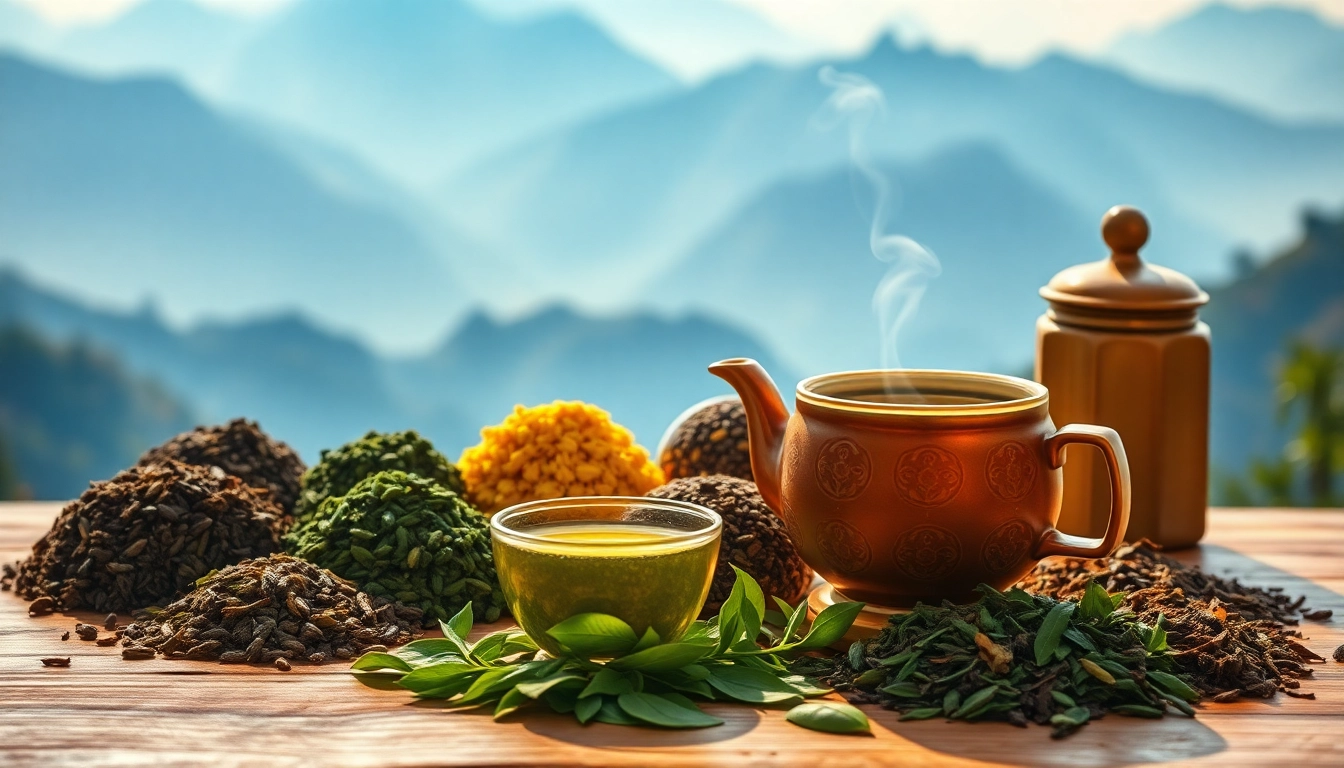Introduction to Best Teas from Nepal
Nepal is often hailed as a hidden gem in the tea world, renowned for producing some of the finest and most unique teas globally. Nestled in the lap of the Himalayas, the country’s exotic geographical features contribute to its rich soil and diverse microclimates, which together foster an ideal environment for tea cultivation. The climate in regions such as Ilam and Kanchanjunga allows for the growth of a variety of tea plants, resulting in flavors that are both distinctive and appealing. As you embark on a journey through the world of Nepali teas, you’ll come to understand why they have gained increasing popularity among tea connoisseurs and casual drinkers alike. If you’re looking to discover the best teas from Nepal, read on to explore what makes these brews so special.
The Rich Heritage of Nepali Tea
The tradition of tea drinking in Nepal dates back centuries, rooted in both cultural rituals and social customs. Initially introduced by Chinese tea traders, production began in earnest during the British colonial era, leading to the establishment of many tea estates. Nepali tea is often characterized by its connection to local culture and heritage; the cultivation and harvesting processes are typically steeped in community involvement, with families working together to maintain tea gardens. This rich heritage not only defines the flavor profiles but also instills a sense of pride within the local communities.
In addition, Nepalese teas often reflect the personalities of their local growing regions. For example, teas from the eastern parts of Nepal, especially those grown at higher altitudes, tend to be more fragrant and complex in flavor. Understanding this heritage is key to appreciating the nuances of each cup.
Understanding Tea Types and Styles
Nepal produces a variety of tea types, ranging from black and green teas to oolong and specialty herbal blends. Each category has its distinct characteristics, derived from the processing methods and the specific varieties of Camellia sinensis or local cultivars used. Here’s a closer look:
- Black Tea: The most popular type in Nepal, black teas from this region are known for their malty sweetness and rich body. Examples include Himalayan Golden Black and Nepalese Gold.
- Green Tea: Known for their health benefits, Nepali green teas are less oxidized and retain a fresh, grassy flavor, often with hints of sweetness.
- Oolong Tea: This semi-oxidized tea has a unique flavor that falls between black and green teas, offering a diverse taste profile based on its levels of oxidation.
Each of these types reflects the local growing conditions, production techniques, and cultural significance, making the exploration of Nepali teas a rich and flavorful adventure.
Health Benefits of Nepali Teas
Sipping on Nepali teas not only satisfies your taste buds but also offers a range of health benefits. The high elevation and organic cultivation methods often used in Nepal result in richer antioxidants compared to teas from other regions. Here are some notable health benefits:
- Antioxidants: Black and green teas are rich in polyphenols and catechins, which help combat oxidative stress and reduce cell damage.
- Heart Health: Regular consumption of black tea has been linked to improved heart health, lowering cholesterol levels, and reducing blood pressure.
- Weight Management: Green tea is known for aiding in weight loss by enhancing metabolic rates.
- Enhanced Focus: The moderate caffeine content combined with L-theanine promotes alertness and focus without the jittery feelings that can come from coffee.
Incorporating Nepali teas into your daily routine may not only improve your physical health but also enhance your overall well-being.
Top-Rated Nepali Teas to Try
Himalayan Golden Black Tea
Recognized as one of Nepal’s finest organic teas, Himalayan Golden Black Tea boasts a distinct profile characterized by its golden-tipped leaves, rich flavor, and award-winning quality. Harvested in the high altitudes of the Himalayan foothills, this tea offers a malty sweetness with notes of fruit and warmth, making it an excellent choice for any tea drinker. Its full-bodied nature makes it ideal for breakfast blends or evening relaxation.
Jin Jun Mei: A Luxury Option
Among the more exclusive offerings from Nepal is Jin Jun Mei, often regarded as a luxury tea. Its production process is labor-intensive, making it less common than other varieties. With a sweet aroma and a palate that exhibits hints of honey and caramel, Jin Jun Mei is ideal for special occasions or for those looking to indulge in a superior tea experience. The experience of sipping this tea feels special, inviting users to savor each sip as they appreciate its artisanal qualities.
The Descriptive Profile of Nepali Green Tea
Nepali Green Tea has gained acclaim for its unique taste and aroma. Renowned for its grassiness with subtle floral notes, it presents a sweet, smooth finish in the cup. This tea is typically plucked in spring, when the young leaves exhibit maximum flavor potential. This timing, combined with meticulous processing, ensures that the tea retains its vital nutrients. Its health benefits are complemented by a refreshing nature, making it an excellent choice for hot summer days or calming evenings.
Brewing Techniques for Optimal Flavor
Water Quality and Temperature Considerations
The quality of water used when brewing tea can significantly affect the final flavor. Ideally, use filtered water free from chlorine or any strong taste that could overpower the delicate notes of Nepali teas. Temperature plays a critical role as well: black teas typically require boiling water (around 200-212°F), while green teas are best brewed at lower temperatures (around 175-185°F) to prevent bitterness and preserve their nuanced flavors.
Traditional vs. Modern Brewing Methods
In Nepal, traditional brewing often includes a method of boiling the tea leaves repeatedly, allowing the flavors to fully develop in a communal pot, sometimes further enriched with milk and spices for chai. In contrast, modern brewing typically favors more discrete preparation methods, focusing on infusers or teapots to allow for precise control of steeping time. Both methods offer unique experiences and can be appreciated for their cultural significance and flavor outcomes.
Pairing Nepali Teas with Food
Pairing tea with food can elevate the taste experience, accentuating flavors and enhancing enjoyment. Here’s how to match some popular Nepali teas with food:
- Himalayan Golden Black Tea: Pairs well with spicy breakfast dishes, buttery pastries, or rich chocolate desserts.
- Nepali Green Tea: Complements light salads, sushi, or lemon-infused dishes.
- Chai: Traditionally served with savory snacks like samosas or sweet treats such as jalebi, enhancing the overall culinary experience.
Experimenting with tea pairings can lead to an exciting exploration of flavors, contributing to a more enjoyable meal.
Where to Buy the Best Teas from Nepal
Local vs. Online Retail Options
When it comes to acquiring quality Nepali teas, consumers today have numerous options. Local specialty tea shops often carry a curated selection, allowing you to explore various types while seeking expert advice. However, online platforms provide a broader variety, often including unique blends that may not be available in physical stores. Shopping online can also give you the advantage of checking customer reviews and comparing prices between different retailers.
Evaluating Quality and Authenticity
When purchasing Nepali teas, it’s essential to ensure their quality and authenticity. Look for certifications such as organic or Fair Trade, and seek out brands that are transparent about their sourcing practices. Authenticity can also be assessed through customer reviews and testimonials that highlight the flavor, aroma, and overall experience of the tea. Understanding the reputation of the seller can significantly affect your purchasing decision.
Customer Reviews and Recommendations
Online reviews can serve as a valuable resource in your search for the best Nepali teas. Platforms like Reddit often host threads where tea enthusiasts share their recommendations, favorite flavors, and brewing tips. Engaging with these communities can provide insight into popular products, allowing you to make informed choices based on collective experiences.
Tea Culture and Tradition in Nepal
Significance of Tea in Nepali Social Life
In Nepal, tea is ingrained in the social fabric, serving as a common thread that brings people together. Whether in the busy streets of Kathmandu or in quiet rural villages, the act of sharing tea fosters connections and conversations among locals. It is customary for hosts to serve tea to guests, reflecting hospitality and creating an environment for dialogue.
Cultural Rituals Surrounding Tea
Cultural rituals centered around tea are diverse. For instance, during festivals and family gatherings, tea is often served alongside traditional snacks, becoming a focal point for celebration. Special blends may also be prepared for religious ceremonies, where tea is regarded as a means of purification and a blessing.
Future Trends in Nepali Tea Production
The future of Nepali tea production looks promising, driven by a growing global demand for organic and ethically sourced products. As local growers respond to this trend, we may see increased collaboration with international tea markets, improved cultivation practices, and innovative processing techniques. The push for sustainability and environmental stewardship is also likely to play a crucial role in shaping how Nepali teas are developed and marketed in the years to come.



